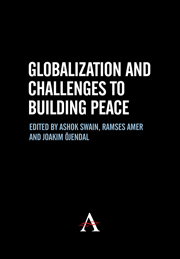Book contents
- Frontmatter
- Contents
- Acknowledgements
- List of Contributors
- 1 Building Peace in the Era of Three Waves
- 2 The Problem of Peace: Understanding the ‘Liberal Peace’
- 3 Pre-emptive Self-defence New Legal Principle or Political Action?
- 4 Beyond Criminal Justice: Promoting the Rule of Law in Post-Conflict Societies
- 5 Peace by Pact: Data on the Implementation of Peace Agreements
- 6 Refugee Repatriation as a Necessary Condition for Peace
- 7 Catapulting Conflicts or Propelling Peace: Diasporas and Civil Wars
- 8 UN Peace Operations as Norm Entrepreneurs: The Challenge of Achieving Communicative Action on Human Rights
- 9 To Practice What They Preach: International Transitional Administrations and the Paradox of Norm Promotion
- 10 Re-examining the Roots of War in West Africa in a Globalizing World
- 11 The African Union (AU) and Its Commitment to Non-Indifference: Can the AU be an Actor for the Promotion of Human Security?
- 12 Hamas Between Sharia Rule and Demo-Islam
- 13 Environmental Scarcity and Intrastate Conflicts: The Case of Nepal
- 14 Narcotics: The New Security Threat for China
- References
- Bibliography
8 - UN Peace Operations as Norm Entrepreneurs: The Challenge of Achieving Communicative Action on Human Rights
Published online by Cambridge University Press: 05 March 2012
- Frontmatter
- Contents
- Acknowledgements
- List of Contributors
- 1 Building Peace in the Era of Three Waves
- 2 The Problem of Peace: Understanding the ‘Liberal Peace’
- 3 Pre-emptive Self-defence New Legal Principle or Political Action?
- 4 Beyond Criminal Justice: Promoting the Rule of Law in Post-Conflict Societies
- 5 Peace by Pact: Data on the Implementation of Peace Agreements
- 6 Refugee Repatriation as a Necessary Condition for Peace
- 7 Catapulting Conflicts or Propelling Peace: Diasporas and Civil Wars
- 8 UN Peace Operations as Norm Entrepreneurs: The Challenge of Achieving Communicative Action on Human Rights
- 9 To Practice What They Preach: International Transitional Administrations and the Paradox of Norm Promotion
- 10 Re-examining the Roots of War in West Africa in a Globalizing World
- 11 The African Union (AU) and Its Commitment to Non-Indifference: Can the AU be an Actor for the Promotion of Human Security?
- 12 Hamas Between Sharia Rule and Demo-Islam
- 13 Environmental Scarcity and Intrastate Conflicts: The Case of Nepal
- 14 Narcotics: The New Security Threat for China
- References
- Bibliography
Summary
Introduction
The far-reaching scope of peacekeeping mandates and the multitude of actors deployed in contemporary peace operations render the application of peace operations as human rights mechanism, much more difficult compared to traditional UN human rights mechanisms. An often overlooked but significant challenge for peace operations acting in such capacity is the establishment of mutual understanding and agreement on human rights between civilian and military peace actors, and the impact of such an agreement – or absence thereof – on the success of peace operations. This aspect involves issues as diverse as inter-agency cooperation, cultural differences between military and civilian actors and how international human rights law is accepted, embraced and ‘operationalized’ in such complex multicultural and politicized settings. Above all, it addresses the issue of how and under which conditions human rights standards and norms are best advocated by peace actors.
The aim of this article is to examine how UN peace operations may enhance their potential of promoting human rights by analysing how peace actors communicate and reach agreement on human rights. The underlying presumption is that effective human rights promotion and protection is contingent on the existence of a common understanding of human rights among different components of a peace operation. Such examination will be undertaken by analysing data collected in the field in the light of discourse theories of human rights, drawing primarily on Jürgen Habermas' theory of communicative action.
- Type
- Chapter
- Information
- Globalization and Challenges to Building Peace , pp. 121 - 144Publisher: Anthem PressPrint publication year: 2007
- 3
- Cited by

